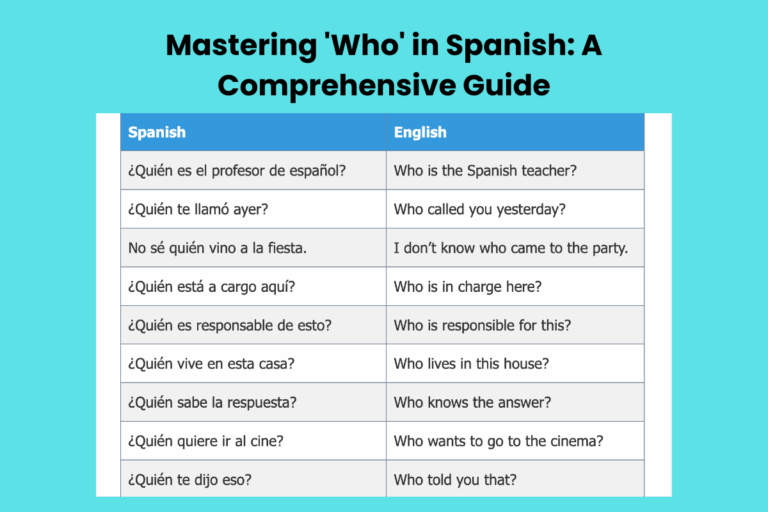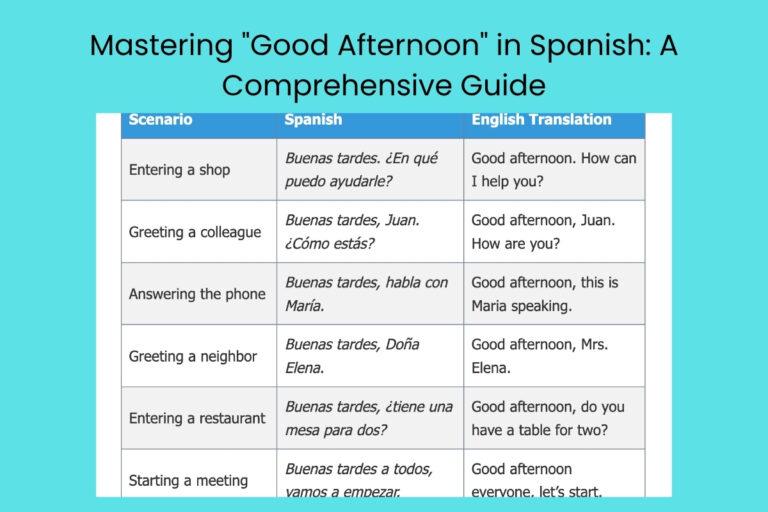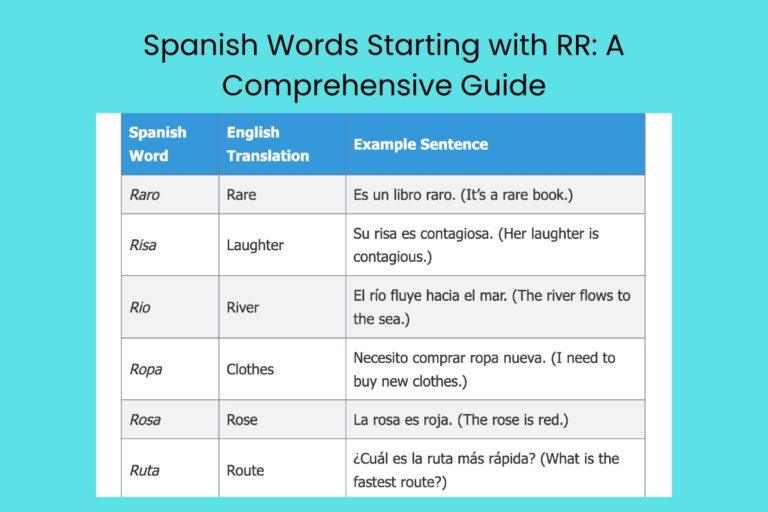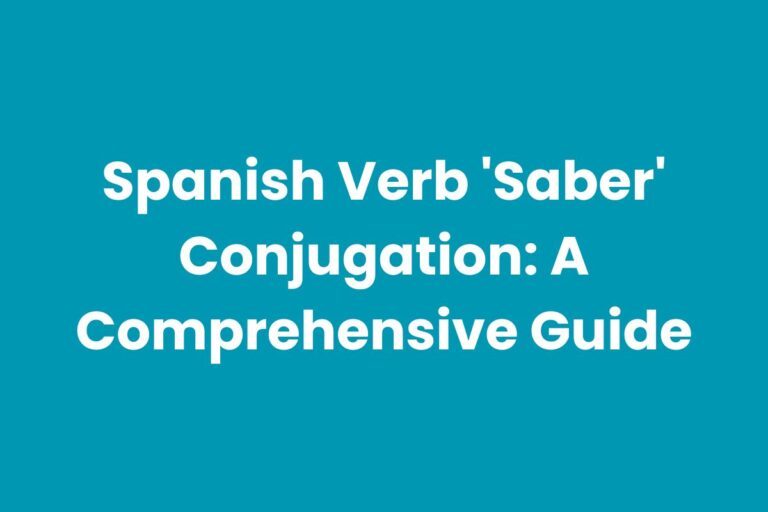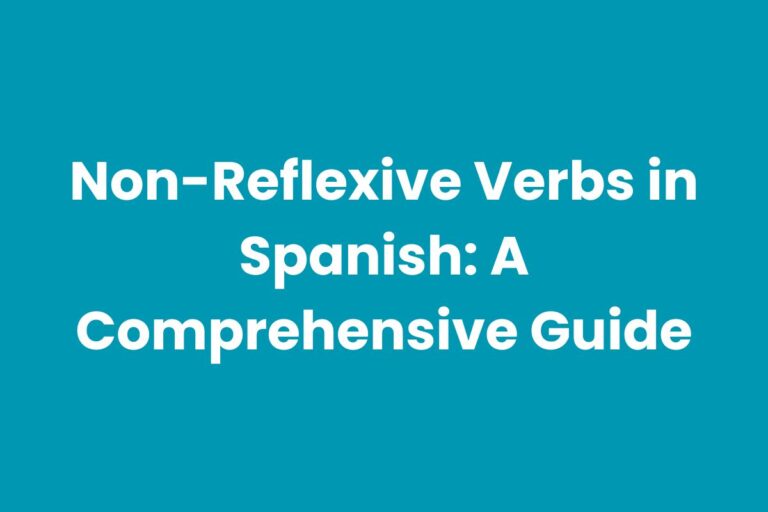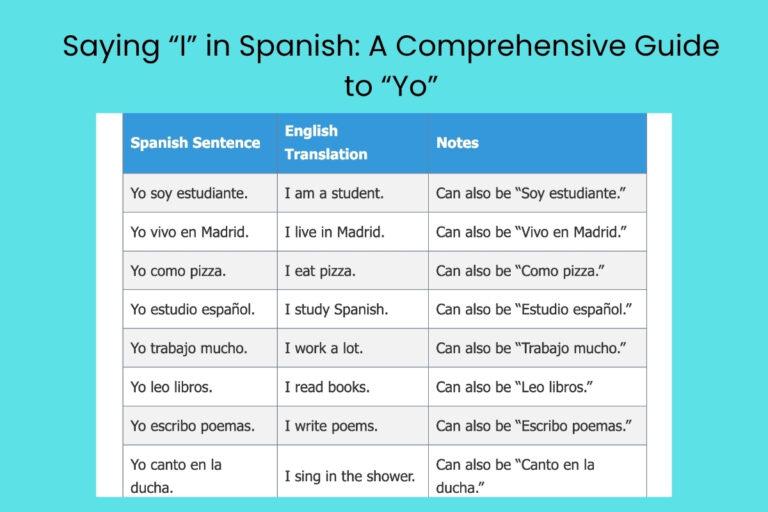Spanish Words Starting with Y: A Comprehensive Guide
Understanding Spanish vocabulary is crucial for effective communication and fluency. While the letter ‘y’ might not be as prevalent as other letters in the Spanish alphabet, mastering the words that begin with it is essential for expanding your lexicon and improving comprehension.
This article provides a detailed exploration of Spanish words starting with ‘y,’ covering their meanings, usage, and grammatical context. Whether you are a beginner or an advanced learner, this guide will enhance your understanding and application of these words in various contexts, from everyday conversations to more formal settings.
Table of Contents
- Introduction
- Definition of Spanish Words Starting with ‘Y’
- Structural Breakdown
- Types and Categories of ‘Y’ Words
- Examples of Spanish Words Starting with ‘Y’
- Usage Rules for Words Starting with ‘Y’
- Common Mistakes When Using ‘Y’ Words
- Practice Exercises
- Advanced Topics
- FAQ
- Conclusion
Introduction
The Spanish language, with its rich history and global presence, presents a fascinating landscape for language learners. While some letters dominate the vocabulary, others, like ‘y,’ hold their own unique significance.
Words beginning with ‘y’ in Spanish, though fewer in number compared to other letters, are essential for complete comprehension and effective communication. This article aims to provide an in-depth exploration of these words, covering their meanings, usage, and grammatical context.
By understanding these words, learners can enhance their vocabulary and overall fluency in Spanish.
This guide is designed for Spanish learners of all levels, from beginners taking their first steps to advanced students seeking to refine their knowledge. Whether you’re preparing for an exam, traveling to a Spanish-speaking country, or simply expanding your linguistic horizons, this comprehensive resource will equip you with the necessary understanding of Spanish words starting with ‘y’.
We will explore the nuances of their meanings, examine their structural components, and provide practical examples to illustrate their usage in various contexts. By the end of this article, you’ll have a solid foundation for using these words confidently and accurately.
Definition of Spanish Words Starting with ‘Y’
Spanish words starting with the letter ‘y’ are a unique subset of the Spanish lexicon. The letter ‘y’ in Spanish, pronounced similarly to the English ‘ee’ when it’s a vowel, or like the ‘y’ in “yellow” when it’s a consonant at the beginning of a word, plays a specific role in the formation and meaning of words.
These words can belong to various grammatical categories, including nouns, verbs, and adverbs, each with its own function and usage. Understanding the definition and context of these words is crucial for effective communication.
The classification of ‘y’ words is primarily based on their grammatical function. Nouns starting with ‘y’ typically refer to objects, places, or concepts, while verbs denote actions or states of being.
Adverbs modify verbs, adjectives, or other adverbs, providing additional information about how, when, where, or to what extent an action is performed. The context in which these words are used often determines their precise meaning and interpretation.
For instance, a word might have different connotations depending on the region or the specific situation in which it is used.
In the Spanish language, the letter ‘y’ also serves as a conjunction, equivalent to the English word “and.” This usage is incredibly common and fundamental to constructing sentences and connecting ideas. However, when the following word starts with the sound /i/ (written as “i” or “hi”), the conjunction changes to “e” to avoid the cacophony of two similar sounds in a row.
This rule is a key aspect of Spanish phonetics and grammar, demonstrating the language’s sensitivity to sound and rhythm.
Structural Breakdown
The structure of Spanish words starting with ‘y’ can provide valuable insights into their etymology and meaning. Many of these words have roots in Greek or Latin, reflecting the historical influences on the Spanish language.
Understanding the prefixes, suffixes, and root words that make up these terms can greatly enhance your ability to decipher their meanings and remember them more effectively. Analyzing the structural components of these words is a useful strategy for expanding your vocabulary and improving your understanding of Spanish grammar.
One common pattern observed in ‘y’ words is the presence of prefixes that alter the meaning of the root word. For example, prefixes such as yu- or yo- can indicate specific qualities or relationships. Similarly, suffixes can denote the grammatical function of a word, such as whether it is a noun, verb, or adjective. By recognizing these patterns, learners can make educated guesses about the meanings of unfamiliar words and improve their overall reading comprehension skills.
Furthermore, the phonetic structure of ‘y’ words is also important to consider. The pronunciation of the ‘y’ can vary depending on its position in the word and the surrounding letters.
In some cases, it may sound like the English ‘y’ in “yes,” while in others, it may be closer to the ‘ee’ sound in “see.” Mastering these phonetic nuances is crucial for accurate pronunciation and effective communication. Pay attention to how native speakers pronounce these words and practice imitating their intonation and rhythm.
Types and Categories of ‘Y’ Words
Spanish words beginning with ‘y’ can be categorized into several types based on their grammatical function and semantic meaning. These categories include nouns, verbs, adverbs, and conjunctions.
Each category has its own unique characteristics and usage patterns. Understanding these distinctions is essential for using these words correctly and effectively in various contexts.
Nouns Starting with ‘Y’
Nouns are words that represent people, places, things, or ideas. In Spanish, nouns starting with ‘y’ are relatively rare but important to know. These words can refer to concrete objects, abstract concepts, or proper nouns. Examples include yacimiento (deposit), yoga (yoga), and yodo (iodine). The gender of these nouns (masculine or feminine) must also be considered for proper agreement with articles and adjectives.
Verbs Starting with ‘Y’
Verbs are words that express actions, occurrences, or states of being. Verbs starting with ‘y’ are less common than nouns but are still essential for constructing sentences and conveying meaning. An example is the verb yacer (to lie, to be located). Understanding the conjugation patterns of these verbs is crucial for using them correctly in different tenses and moods.
Adverbs Starting with ‘Y’
Adverbs are words that modify verbs, adjectives, or other adverbs, providing additional information about how, when, where, or to what extent something is done. Adverbs starting with ‘y’ are rare in Spanish.
An example might be a derivative of another word, adapted to function adverbially.
Conjunctions Starting with ‘Y’
The most common and important ‘y’ word is the conjunction y (and). This word is fundamental to connecting words, phrases, and clauses in Spanish. As mentioned earlier, it changes to e before words that start with the /i/ sound. This rule is a key aspect of Spanish grammar and phonetics.
Examples of Spanish Words Starting with ‘Y’
To solidify your understanding of Spanish words starting with ‘y,’ let’s explore a variety of examples categorized by their grammatical function. These examples will illustrate how these words are used in different contexts and provide a practical foundation for incorporating them into your own vocabulary.
Examples of Nouns Starting with ‘Y’
Nouns are essential for describing objects, places, and concepts. The following table provides examples of nouns starting with ‘y’ in Spanish, along with their English translations and example sentences.
| Spanish Noun | English Translation | Example Sentence |
|---|---|---|
| Yacimiento | Deposit, Site | El yacimiento de petróleo es muy grande. (The oil deposit is very large.) |
| Yoga | Yoga | Practico yoga todos los días. (I practice yoga every day.) |
| Yodo | Iodine | Necesitamos yodo para la salud de la tiroides. (We need iodine for thyroid health.) |
| Yegua | Mare | La yegua corrió muy rápido. (The mare ran very fast.) |
| Yelmo | Helmet | El caballero llevaba un yelmo brillante. (The knight wore a shining helmet.) |
| Yema | Yolk | La yema del huevo es muy nutritiva. (The yolk of the egg is very nutritious.) |
| Yerno | Son-in-law | Mi yerno es un hombre muy amable. (My son-in-law is a very kind man.) |
| Yeso | Plaster | La pared está cubierta de yeso. (The wall is covered in plaster.) |
| Yuca | Cassava | La yuca es un tubérculo muy común en América Latina. (Cassava is a very common tuber in Latin America.) |
| Yugo | Yoke | Los bueyes llevaban un yugo de madera. (The oxen wore a wooden yoke.) |
| Yate | Yacht | El yate navegaba por el Mediterráneo. (The yacht was sailing through the Mediterranean.) |
| Yardas | Yards | Necesito tres yardas de tela. (I need three yards of fabric.) |
| Yak | Yak | El yak es un animal de carga en el Himalaya. (The yak is a pack animal in the Himalayas.) |
| Yogur | Yogurt | Me gusta el yogur con frutas. (I like yogurt with fruit.) |
| Yacuzzi | Jacuzzi | Relajarse en un jacuzzi es muy agradable. (Relaxing in a jacuzzi is very pleasant.) |
| Yukata | Yukata (Japanese robe) | Llevaba una yukata tradicional japonesa. (She was wearing a traditional Japanese yukata.) |
| Yarda | Yard (unit of measurement) | La yarda es una unidad de medida común. (The yard is a common unit of measurement.) |
| Yugoslave | Yugoslavian | Ella es de origen yugoslavo. (She is of Yugoslavian origin.) |
| Yuxtaposición | Juxtaposition | La yuxtaposición de ideas crea un contraste interesante. (The juxtaposition of ideas creates an interesting contrast.) |
| Yarey | Type of Palm | El techo estaba hecho de hojas de Yarey. (The roof was made of Yarey palm leaves.) |
| Yacaré | Caiman | El yacaré es un reptil de América del Sur. (The caiman is a reptile from South America.) |
| Yola | Small Boat | Los pescadores salieron en su yola. (The fishermen went out in their small boat.) |
| Yantar | Food, Meal (archaic) | El yantar fue abundante y delicioso. (The meal was abundant and delicious.) |
| Yapa | Bonus, Extra | El vendedor me dio una yapa. (The seller gave me a bonus.) |
Examples of Verbs Starting with ‘Y’
Verbs express actions and states of being. The following table provides examples of verbs starting with ‘y’ in Spanish, along with their English translations and example sentences.
Note that these verbs are quite rare.
| Spanish Verb | English Translation | Example Sentence |
|---|---|---|
| Yacer | To lie, to be located | Sus restos yacen en la tumba familiar. (His remains lie in the family tomb.) |
| Yuxtaponer | To juxtapose | El artista yuxtapuso colores contrastantes. (The artist juxtaposed contrasting colors.) |
| Yodar | To iodize | Es importante yodar la sal para prevenir enfermedades. (It is important to iodize salt to prevent diseases.) |
| Yermar | To lay waste, to leave barren | La sequía yermó la tierra. (The drought laid the land waste.) |
Examples of Conjunctions Starting with ‘Y’
Conjunctions connect words, phrases, and clauses. The conjunction y (and) is one of the most common words in Spanish. The following table illustrates its usage, including when it changes to e.
| Spanish Conjunction | English Translation | Example Sentence |
|---|---|---|
| Y | And | Quiero café y leche. (I want coffee and milk.) |
| E | And (before words starting with /i/) | Padre e hijo fueron al parque. (Father and son went to the park.) |
| Y…y | Both…and | Y Juan y María están invitados. (Both Juan and María are invited.) |
Examples of Words starting with “Ye”
Words that start with “Ye” are also relatively rare, but it’s useful to know some common examples. These words can be nouns or adjectives, and are often found in specific contexts.
| Spanish Word | English Translation | Example Sentence |
|---|---|---|
| Yelmo | Helmet | El caballero llevaba un yelmo brillante. (The knight wore a shining helmet.) |
| Yema | Yolk | La yema del huevo es muy nutritiva. (The yolk of the egg is very nutritious.) |
| Yemení | Yemeni (adjective) | La comida yemení es muy especiada. (Yemeni food is very spicy.) |
Usage Rules for Words Starting with ‘Y’
Using Spanish words starting with ‘y’ correctly requires an understanding of specific grammar rules and contextual nuances. These rules govern the agreement of nouns with articles and adjectives, the conjugation of verbs in different tenses and moods, and the proper use of the conjunction y. Mastering these rules is essential for accurate and effective communication in Spanish.
Noun-Adjective Agreement: Nouns starting with ‘y’ must agree in gender and number with the articles and adjectives that modify them. For example, if the noun is masculine singular, the article and adjective must also be masculine singular. If the noun is feminine plural, the article and adjective must be feminine plural. This agreement is a fundamental aspect of Spanish grammar and applies to all nouns, regardless of the letter they start with.
Verb Conjugation: Verbs starting with ‘y’ must be conjugated correctly to reflect the tense, mood, and subject of the sentence. This requires knowledge of the verb’s conjugation patterns and the appropriate endings for each tense and mood. Irregular verbs may have unique conjugation patterns that must be memorized. Pay close attention to the stem changes and irregular forms of these verbs.
Conjunction ‘Y’: The conjunction y is used to connect words, phrases, and clauses in Spanish. However, it changes to e before words that start with the /i/ sound (written as “i” or “hi”). This rule is designed to avoid the cacophony of two similar sounds in a row. For example, you would say “padre e hijo” (father and son) instead of “padre y hijo.”
Common Mistakes When Using ‘Y’ Words
Even experienced Spanish learners can make mistakes when using words starting with ‘y.’ These mistakes often involve incorrect noun-adjective agreement, improper verb conjugation, or misuse of the conjunction y. Being aware of these common errors and practicing correct usage can help you avoid them and improve your accuracy in Spanish.
Incorrect Noun-Adjective Agreement: One common mistake is failing to make nouns and adjectives agree in gender and number. For example, saying “el yema amarillo” instead of “la yema amarilla” (the yellow yolk) is incorrect because yema is a feminine noun. Always double-check the gender and number of nouns and ensure that the articles and adjectives agree.
Improper Verb Conjugation: Another common mistake is conjugating verbs incorrectly. For example, using the wrong tense or mood, or failing to account for irregular verb forms, can lead to confusion and miscommunication. Practice verb conjugations regularly and pay attention to the specific rules for each tense and mood.
Misuse of the Conjunction ‘Y’: Forgetting to change the conjunction y to e before words starting with the /i/ sound is a common error. For example, saying “padre y hijo” instead of “padre e hijo” is incorrect. Remember to apply this rule whenever the following word begins with the /i/ sound.
The table below shows some common mistakes and their corrections:
| Incorrect | Correct | Explanation |
|---|---|---|
| El yema es delicioso. | La yema es deliciosa. | “Yema” is a feminine noun, so it needs a feminine article and adjective. |
| Padre y hijo fueron. | Padre e hijo fueron. | “Y” changes to “e” before words starting with the /i/ sound. |
| Yo y mi amigo. | Mi amigo y yo. | In general, it’s more polite to put yourself last. |
Practice Exercises
To reinforce your understanding of Spanish words starting with ‘y,’ complete the following practice exercises. These exercises will test your knowledge of vocabulary, grammar, and usage.
Be sure to check your answers against the provided solutions to identify areas where you may need further review.
Exercise 1: Vocabulary Matching
Match the Spanish word with its English translation.
| Spanish Word | English Translation |
|---|---|
| 1. Yacimiento | A. Mare |
| 2. Yoga | B. Iodine |
| 3. Yodo | C. Deposit |
| 4. Yegua | D. Plaster |
| 5. Yeso | E. Yoga |
Answers: 1-C, 2-E, 3-B, 4-A, 5-D
Exercise 2: Fill in the Blanks
Fill in the blanks with the correct Spanish word starting with ‘y’.
- Necesito ___________ para curar la herida. (Iodine)
- Practico ___________ para relajarme. (Yoga)
- El ___________ de petróleo es muy importante. (Deposit)
- La ___________ corrió muy rápido. (Mare)
- La pared está cubierta de ___________. (Plaster)
Answers: 1. yodo, 2. yoga, 3. yacimiento, 4. yegua, 5. yeso
Exercise 3: Sentence Completion
Complete the following sentences using appropriate words starting with ‘y’.
- Mi ________ es un hombre muy amable.
- El ________ navegaba por el mar.
- Quiero café ________ leche.
- Es importante ________ la sal.
- Sus restos ________ en la tumba familiar.
Answers: 1. yerno, 2. yate, 3. y, 4. yodar, 5. yacen
Exercise 4: True or False
Decide whether the following sentences are true or false based on Spanish grammar rules.
- “Y” always remains “y” no matter the following word.
- “Yema” is a masculine noun.
- “Yacer” is a verb.
- “Yogur” is a type of dessert.
- You can never start a sentence with “Y”.
Answers: 1. False, 2. False, 3. True, 4. True, 5. False
Exercise 5: Translation
Translate the following sentences into Spanish using words starting with “y” where appropriate.
- My son-in-law is a doctor.
- I like yogurt with fruit.
- The helmet protected the knight.
- The oil deposit is very large.
- Father and son went fishing.
Answers: 1. Mi yerno es médico., 2. Me gusta el yogur con fruta., 3. El yelmo protegió al caballero., 4. El yacimiento de petróleo es muy grande., 5. Padre e hijo fueron a pescar.
Advanced Topics
For advanced learners, exploring the etymology and historical usage of Spanish words starting with ‘y’ can provide a deeper understanding of the language. Delving into the origins of these words can reveal fascinating connections to other languages and cultures.
Additionally, examining literary and historical texts can shed light on how these words have been used in different contexts over time.
Researching the etymology of words like “yacimiento” (deposit) or “yodo” (iodine) can reveal their roots in Latin or Greek, providing insights into the scientific and cultural influences on the Spanish language. Understanding these connections can enhance your vocabulary and improve your ability to recognize related words in other languages.
Furthermore, analyzing the use of the conjunction y in classic Spanish literature can provide a nuanced understanding of its role in connecting ideas and creating coherence in writing. Pay attention to how authors use this conjunction to create rhythm, emphasis, and flow in their texts. By studying these advanced topics, you can deepen your appreciation for the richness and complexity of the Spanish language.
FAQ
Here are some frequently asked questions about Spanish words starting with ‘y’:
- Why are there so few Spanish words starting with ‘y’?
The scarcity of Spanish words starting with ‘y’ is primarily due to the historical development of the language. Many words that might have started with a ‘y’ sound in Latin or other ancestral languages have evolved to begin with different letters in Spanish. Additionally, the letter ‘y’ has specific phonetic roles in the language, which limits its usage as an initial letter.
- When should I use ‘e’ instead of ‘y’ as a conjunction?
You should use ‘e’ instead of ‘y’ when the following word starts with the /i/ sound, which is typically written as “i” or “hi.” This rule is designed to avoid the cacophony of two similar sounds in a row, making the pronunciation smoother and more pleasant.
- Are there any regional variations in the pronunciation of ‘y’?
Yes, there are regional variations in the pronunciation of ‘y’ in Spanish. In some regions, particularly in Argentina and Uruguay, the ‘y’ is pronounced like the English ‘sh’ sound. In other regions, it is pronounced more like the ‘y’ in “yes” or the ‘ee’ in “see.”
- How can I improve my vocabulary of Spanish words starting with ‘y’?
To improve your vocabulary of Spanish words starting with ‘y,’ focus on reading widely in Spanish, paying attention to the context in which these words are used. Use flashcards, language learning apps, and online resources to memorize new words and practice their pronunciation. Additionally, try to incorporate these words into your own speaking and writing to reinforce your learning.
- Is it important to know the gender of nouns starting with ‘y’?
Yes, it is essential to know the gender of nouns starting with ‘y’ because Spanish requires agreement between nouns and their articles and adjectives. Using the wrong gender can lead to grammatical errors and confusion. Always learn the gender of a noun when you learn the word itself.
- Are there any common idioms or expressions that use words starting with ‘y’?
While there aren’t many common idioms specifically centered around words starting with ‘y’, the conjunction ‘y’ is used extensively in countless expressions. For example, “ir y venir” (to come and go) is a common expression that uses the conjunction ‘y’.
- How does the ‘y’ sound differ from the ‘ll’ sound in Spanish?
The ‘y’ and ‘ll’ sounds in Spanish can be confusing for learners because their pronunciation varies by region. In some regions, they are pronounced identically, while in others, ‘ll’ has a distinct ‘ly’ sound. The ‘y’ sound is generally more consistent across regions, resembling the English ‘y’ in “yes” or the ‘ee’ in “see.”
- Are there loanwords in Spanish that start with ‘y’?
Yes, there are loanwords in Spanish that start with ‘y,’ often from English or other languages. Examples include “yak” (yak), “yate” (yacht), and “yogur” (yogurt). These words have been adopted into the Spanish lexicon and are used in everyday conversation.
- What is the best way to practice using the conjunction ‘y’ correctly?
The best way to practice using the conjunction ‘y’ correctly is to focus on sentence construction and pay attention to the sound of the following word. Practice connecting words, phrases, and clauses using ‘y’ and remember to change it to ‘e’ before words starting with the /i/ sound. Read and listen to Spanish regularly to reinforce your understanding of this rule.
- Can ‘y’ ever be part of a diphthong in Spanish?
Yes, ‘y’ can form a diphthong at the end of a word if it follows a vowel. In this case, it functions as a vowel and is pronounced like the “ee” in “see”. For example, in the word “Uruguay,” the “y” creates a diphthong with the “a.”
Conclusion
Mastering Spanish words starting with ‘y’ is an essential step toward achieving fluency and confidence in the language. While these words may be fewer in number compared to those beginning with other letters, understanding their meanings, usage rules, and grammatical context is crucial for effective communication.
By exploring the various categories of ‘y’ words, practicing their usage in different contexts, and avoiding common mistakes, learners can significantly enhance their vocabulary and overall language proficiency.
Remember to focus on noun-adjective agreement, verb conjugation, and the proper use of the conjunction y. Regularly review and practice these concepts to reinforce your understanding. Additionally, consider exploring advanced topics such as etymology and historical usage to deepen your appreciation for the richness and complexity of the Spanish language. With consistent effort and dedication, you can confidently incorporate Spanish words starting with ‘y’ into your everyday conversations and written communication.


